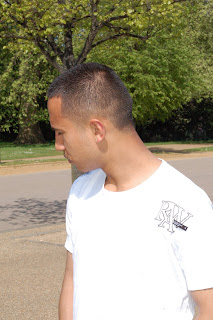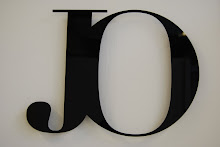Sunday, 31 May 2009
Project Evaluation
Monday, 18 May 2009
Final Poster Images
Final Project Space Proposal
Final Project Space Proposal
I am creating a window and store layout for a high fashion men store. The final presentation of my work will need to be a scale model of what the features will appear inside a store. I am requesting 3meter wall space to full be able to present my work to the fullest light. So to give the atmosphere of you are in a high fashion store .I will be having two posters showing male models, the poster will be 60cm width and 2.5 meter long. The logo will be 60cm squared as that is the average size for an in store logo cutout that normally place on walls. I be have some folded clothes on a wall shelf and the clothes will be folded to the standard of high fashion brand. The shelf is a length of 110cm x Depth 26cm Thickness 5cm. There will be a clothed manikin on display, which the fashion department has kindly allowed me to borrow for the show.
I do understand that a large wall space to be requesting, but it is fully needed to fulfill the vision that I have for this project and to take it to that next stage of making it into a real high fashion mans store. I have also invited the head creative of the Arcadia group to come to the degree show and that are all more than willing to come and see the out come of the project.
Visual merchandising Explained
Visual merchandising, until recently called simply merchandising, is the activity of promoting the sale of goods, especially by their presentation in retail outlets.(New Oxford Dictionary of English, 1999, Oxford University Press). This includes combining product, environment, and space into a stimulating and engaging display to encourage the sale of a product or service. It has become an important element in retailing that is a team effort involving senior management, architects, merchandising managers, buyers, the visual merchandising director, designers, and staff. Visual merchandising starts with the store building itself. The management decides on the store design to reflect the products the store is going to sell and how to create a warm, friendly, and approachable atmosphere for its potential customers.
Many elements can be used by visual merchandisers in creating displays, including colour, lighting, space, product information, sensory inputs such as smell, touch, and sound as well as technologies such as digital displays and interactive installations.
Visual merchandising is not a science; there are no absolute rules. It is more like an art in the sense that there are implicit rules but that these also exist to be broken for striking effects. The main principle of visual merchandising is that it is intended to increase sales, which is not the case with a "real" art.
Visual merchandising is one of the final stages in trying to set out a store in a way that customers will find attractive and appealing and it should follow and reflect the principles that underpin the store’s image. Visual merchandising is the way one displays 'goods for sale' in the most attractive manner with the end purpose of making a sale. "If it does not sell, it is not visual merchandising."
Especially in today’s challenging economy, people may avoid designers/ visual merchandisers because they fear unmanageable costs. But in reality, visual merchandisers can help economies by avoiding costly mistakes. With guidance of a professional, retailer can eliminate errors, saving time and money. It is important to understand that the visual merchandiser is there, not to impose ideas, but to help clients articulate their own personal style.
Visual merchandising is the art of implementing effective design ideas to increase store traffic and sales volume. VM is an art and science of displaying merchandise to enable maximum sale. VM is a tool to achieve sales and targets, a tool to enhance merchandise on the floor, and a mechanism to communicate to a customer and influence his decision to buy. VM uses season-based displays to introduce new arrivals to customers, and thus increase conversions through a planned and systematic approach by displaying stocks available.
Monday, 11 May 2009
My Project Diary
Week 1
Week 2
Week 3
Visual Merchandising
- Visit different types of stores in the Knightsbridge area, with regards to design concept, materials, store names and aesthetic. Are there any similarities and is this due to the demographic location. Do a Comparative Shop.
- Store design of the Brands mentioned, with regards to location, materials, layouts, garment displays.
- Who is your target audience and why will they want to shop at your store? PEN PROFILE / SOCIO-ECONOMICS.
- What are your brand values?
- What will differentiate your store from your competition?
- Who is your competition?
- Will it be affected by the recession?
- How frequently will the window displays be changed? Note: boutiques generally changed weekly, with garment up-dates to promote latest stock.
- Props? Permanent or non-permanent
- Where will the materials by sourced and why? Cheaper / quality / environmental / innovation
- Do you have a budget and are there any areas where you could save money?
- Comparative shop – research (photograph) stores for design inspiration
- Mood board – collate images found (secondary and primary research)
- Pick key garments / trends to promote in-store.
- Create a design scheme around the chosen trends. Note: the design scheme must be flexible, enabling you to up-date the store layout / windows.
- Send designs to suppliers for quotations
- Create a 2D example of your desired window / layout.
- Install in-store – the design should represent your stores values and encourage your consumer to want to shop.
- Trend info – using info collected, create a trend booklet this will help direct and support decisions made at a later stage.
- Component positioning – computer generate example of how your garments/ props will be displayed in the window(s) and in-store.
- Garment positioning – key garments should be found at the front of the store. This should be monitored weekly to maximise product exposure.
- Layout – garments and accessories should be displayed throughout the store. Display key pieces on mannequins, with accessories to compliment.
- Mannequins - styled to promote and represent the key trends.
- Checklist – of all the visual merchandising elements and previous ideas.







































